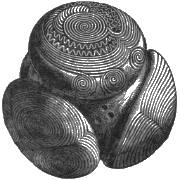Canmore Site 31936: DUNDEE LAW - DUNDEE (DUNDEE, CITY OF) - FORT (IRON AGE), FORTIFICATION (MEDIEVAL)
Description
| Site Name | DUNDEE LAW |
|---|---|
| Other Name(s) | n/a |
| Site Number | NO33SE 32 |
| Broad Class | MONUMENT (BY FORM), DEFENCE, DOMESTIC |
| Site Type(s) | FORT (IRON AGE), FORTIFICATION (MEDIEVAL) |
| NGR | NO 3914 3131 |
| NGR accuracy | NGR given to the nearest 10m |
| Local Authority | DUNDEE, CITY OF |
| Parish | DUNDEE (DUNDEE, CITY OF) |
| Record created | 1988-02-29 |
| Last updated | 2005-10-10 |
Archaeology Notes
NO33SE 32.00 3914 3131
NO33SE 32.01 NO 3914 312 War Memorial
(NO 3914 3131) Fort (NR)
OS 1:10,000 map, (1975)
The fort occupying the summit of Dundee Law was badly disturbed during the construction of the war memorial (NO33SE 32.01) in 1923, when the S end was completely destroyed. The N rampart, although cut through by a path at one point, is now the most intact; it is 5.4m thick. The lines of the E and W ramparts also survive to some extent.
Christison's (1900) plan of 1899 shows a rectangular structure with what may have been an annexe at the N end. Overall, the fort, which occupied the whole of the summit of the Law, measured 79.2m x 51.8m, and its defences were so rectilinear in form that he compared it to Roman works. He also noted that, in the inner area, 'A' was slightly raised above 'B'. He claimed that the ramparts were largely of earth, but since that time the fort has been included in several lists of Scottish vitrified forts. Also, in 1964, during the erection of a television mast at the N edge of the summit, a mechanical excavator revealed two almost parallel lines of boulders, 2'6" below the surface, along the line of the rampart.
The only known artifact from the fort - a steatite cup-shaped lamp, found when excavating for the war memorial - is in Dundee Museum. (Acc No: 1964-55).
Warden (1880-5) notes that the forces of Edward I, Montrose, and Monk occupied the Law, and their entrenchments must have considerably changed the original appearance of the work.
A J Warden 188-5; D Christison 1900; H Coutts 1970; 1971; J D Boyd 1964.
Though the S, and much of the E, limits of the fort as planned by Christison have been destroyed, and the site considerably mutilated, its rectangular form is still apparent. The N rampart is best preserved, 9.0m in width overall and 1.75m maximum height. A small brick building at NO 3914 3133 breaks the outer scarp very slightly, and a modern path 2.25m wide cuts through the rampart at NO 3915 3133. E of this break, the rampart projects for some way as shown on Christison's plan, and continues downhill to merge with the natural slopes. The counter-scarp of the E bank has been considerably destroyed, while its scarp slope remains 1.75m high, extending S to the edge of the road and gradually decreasing in height. Part of the counter-scarp remains near the S end, 0.5m high. Of the W rampart, the scarp remains 1.0m high, and the counter-scarp 0.6m high in the N. This bank curves noticeably westwards towards the S end, but his may be the result of modern mutilation.
These banks are mainly of earth and small stones. The interior is uneven, and slopes downwards towards the E. The slightly raised platform - 'A' on Christison's plan - can just be noticed, but is not surveyable. Occasional protruding stones on the N and W edges of the summit suggest the annexe noted by Christison.
Two or three vitrified stones, said to be from the Law, are in Dundee Museum, the details of the finds being unknown to Mr Boyd (curator, Dundee Museum).
The work is probably in Iron Age fort, having medieval alterations as suggested by Warden.
Visited by OS (J L D) 17 April 1958.
An assessment of the archaeological potential of the fort was carried out in February and March 1990. A resistivity survey of the internal area followed by trial-trenching designed to locate internal structures proved inconclusive. The N and W ramparts, and part of the internal area were investigated and dating samples were recovered. Finds included a perforated stone and pieces of slag.
Sponsors: Dundee District Council; HBM.
J S Rideout 1990.
Excavations occassioned by environmental improvements have revealed fortifications on the summit dating from two widely separated eras. The first fortifications date from the Iron Age and were severely burnt and vitrified; the later earthwork fortifications were probably raised in the 16th century. Consideration is given to the form of the later earthworks and the historical significance of the Law to Dundee.
S Driscoll 1995.
Identifiers and Links to Other Records
This record has no links! Would you like to help?
| Identifier / External Link | Linked Record | Status | Comment |
|---|---|---|---|
| Canmore Site Number (legacy): NO33SE 32 | No linked record |
This area is visible only to logged in users.
